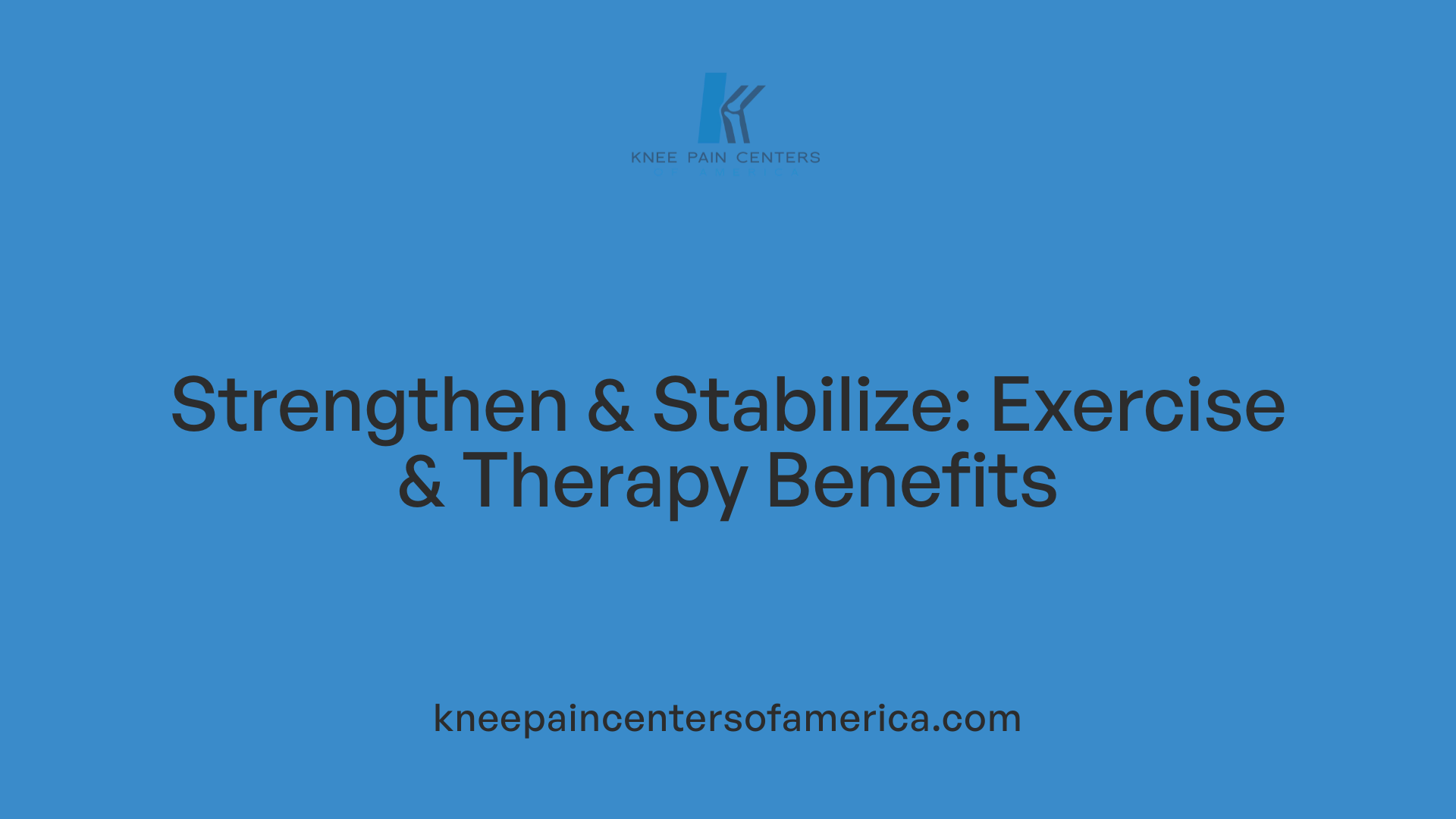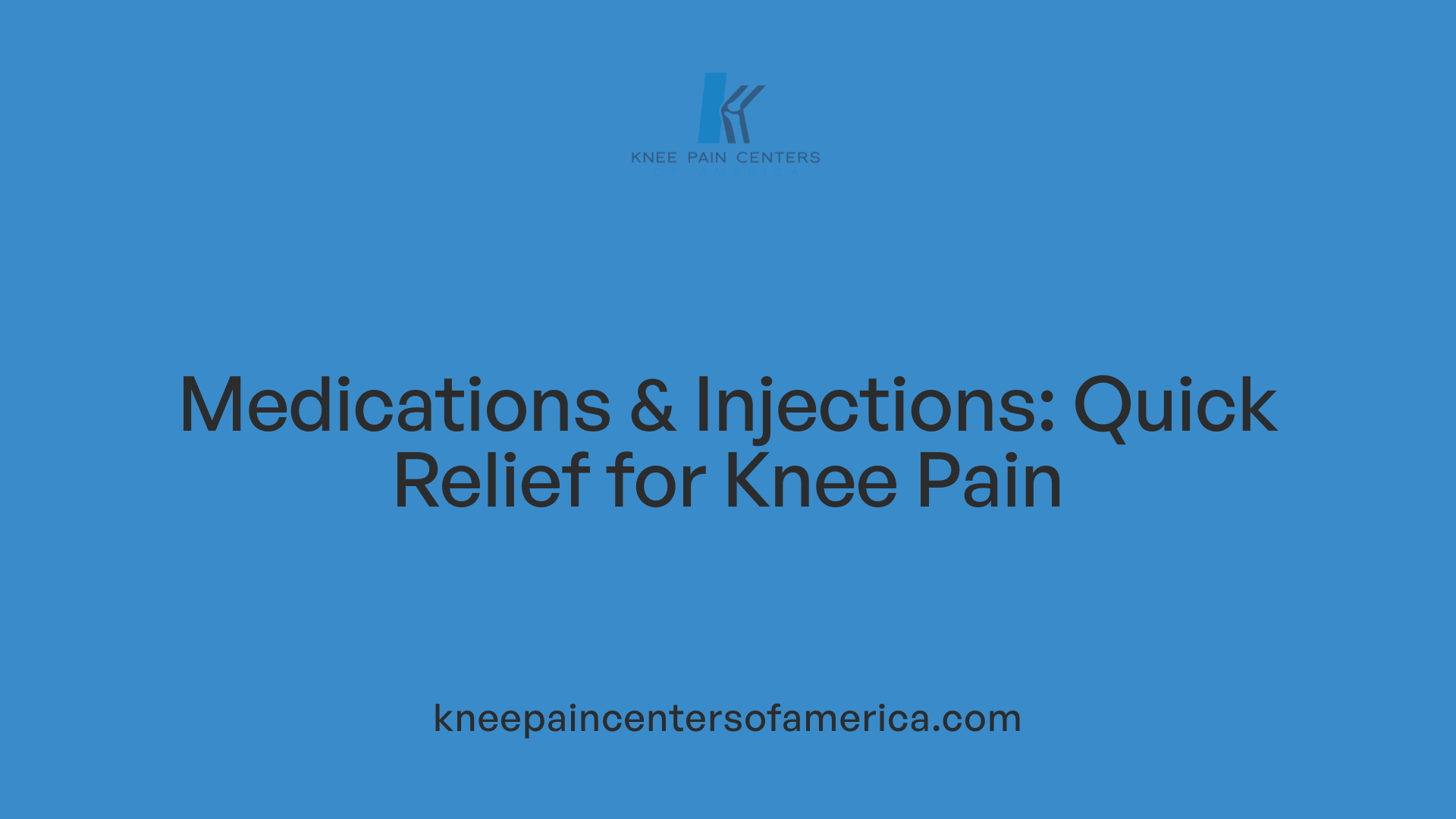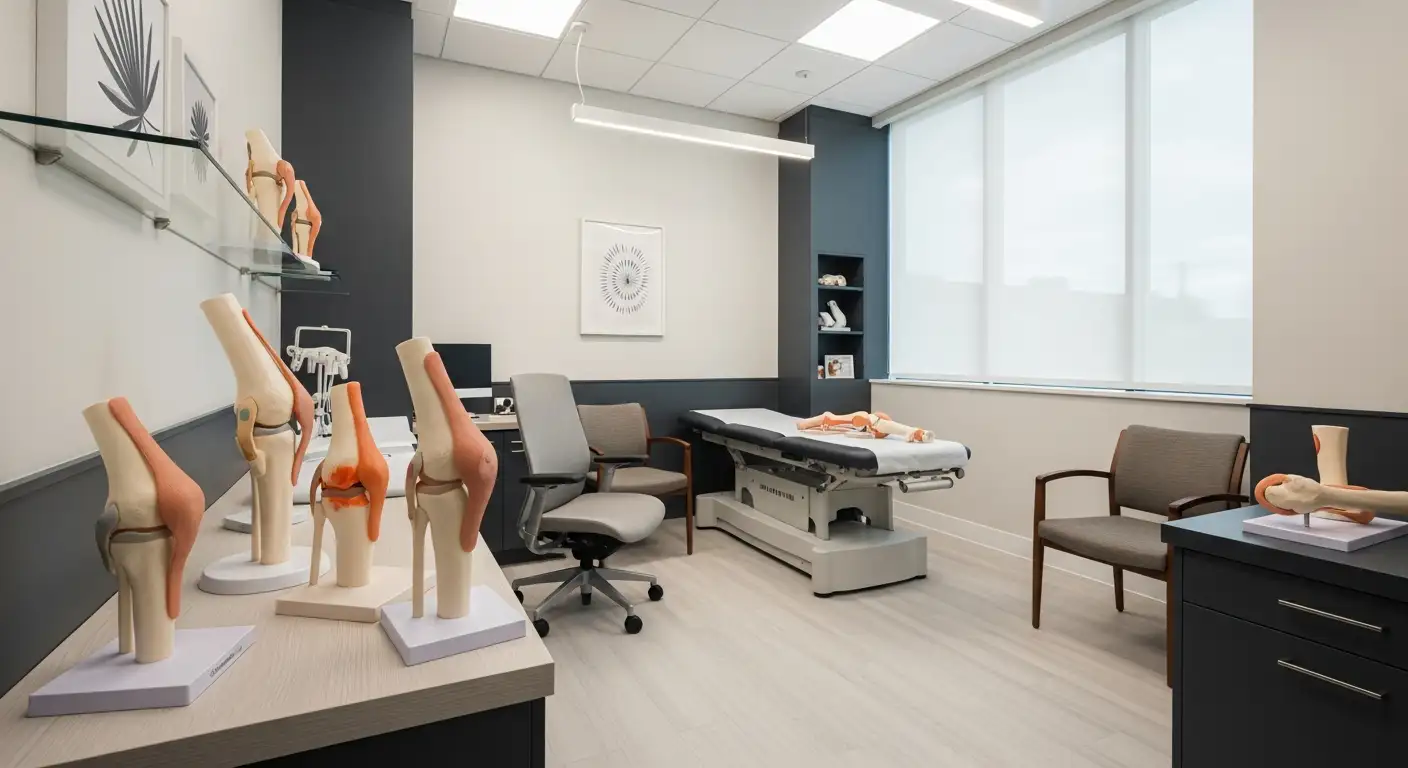Understanding Osteoarthritis and Its Impact on Knee Health
Osteoarthritis (OA) of the knee is a chronic condition characterized by the gradual breakdown of cartilage, leading to painful bone-on-bone contact, swelling, stiffness, and limitations in mobility. Affecting millions, this degenerative joint disease progresses through stages from minor cartilage wear to severe joint immobility. While treatment options range from medications to surgery, lifestyle changes remain foundational in managing symptoms and maintaining joint function. This article explores effective lifestyle modifications and medical treatments that empower individuals to better manage knee osteoarthritis pain and improve quality of life.
The Role of Exercise and Physical Therapy in Osteoarthritis Management

How do physical therapy and exercise help manage knee osteoarthritis?
Physical therapy and exercise are essential components in managing knee osteoarthritis. They focus on strengthening the muscles surrounding the knee, including the hips, core, and legs, which plays a vital role in stabilizing the joint and reducing cartilage wear. Strengthened support muscles help absorb shock and distribute weight more evenly across the joint.
Physical therapy benefits
Physical therapy incorporates targeted exercises, manual therapy, and therapeutic modalities such as heat, cold, and electrical stimulation. These approaches reduce pain and inflammation, improve joint flexibility, and increase range of motion, making movements easier and reducing stiffness.
How exercise strengthens knee-supporting muscles
Exercise helps build muscle strength around the knee, which lessens the joint load and improves function. Strengthening exercises focus on quadriceps and hamstrings, critical for knee stability. Core and hip strengthening also enhance overall lower limb alignment, preventing excessive joint stress.
Improvement of flexibility and mobility
Stretching and range-of-motion activities increase joint flexibility, helping counteract stiffness common after periods of inactivity. This enhancement in mobility allows for smoother, less painful movement.
Managing pain and stiffness through activity
Regular physical activity helps alleviate pain and stiffness, even if some discomfort occurs initially. Low-impact exercises such as walking, cycling, swimming, and yoga are recommended to maintain joint health without inflicting further damage.
Impact on delaying surgery
By improving muscle support, reducing pain, and increasing mobility, physical therapy and exercise can delay or potentially prevent the need for surgical interventions such as knee replacement. They contribute significantly to maintaining independence and quality of life for patients with knee osteoarthritis.
Weight Management: A Key Lifestyle Modification

How does body weight impact stress on the knees?
Carrying excess body weight significantly increases the stress placed on the knee joints. For every pound lost, there is approximately a four-pound reduction in pressure on weight-bearing joints like the knees. This extra load accelerates cartilage wear and exacerbates osteoarthritis symptoms such as pain, stiffness, and swelling.
How does weight loss improve osteoarthritis symptoms?
Losing weight reduces the mechanical burden on the knee, which can lead to decreased pain and improved joint function. Clinical studies support that even a modest weight loss of about 10% of excess body weight can lead to meaningful symptom relief and slower progression of osteoarthritis.
What are the diet and physical activity recommendations for weight management?
Balanced, nutritious diets that support gradual and sustained weight loss are advised alongside regular physical activity. Low-impact exercises like walking, cycling, swimming, yoga, and water aerobics are recommended to strengthen muscles around the knee and improve flexibility without adding undue stress.
What do statistics show about the benefits of weight loss?
Research indicates that losing one pound reduces knee joint load by four pounds, emphasizing the multiplicative benefit of weight reduction. This direct relationship illustrates why weight management is a critical component in managing knee osteoarthritis effectively.
Pain Relief Through Medications and Injections

What are the most common medical treatments for knee pain and osteoarthritis?
Managing knee osteoarthritis (OA) involves a combination of therapies aimed at reducing pain and improving function. Common medical treatments include physical therapy, which strengthens the muscles supporting the knee and enhances flexibility. Alongside this, pain relievers such as acetaminophen and NSAIDs (both oral and topical forms) are frequently used to alleviate discomfort and reduce inflammation.
Injections are another valuable tool. Corticosteroid injections directly decrease inflammation inside the joint, delivering quick relief for weeks to months. Hyaluronic acid injections aim to improve joint lubrication and cushioning, although evidence of their effectiveness is variable.
Lifestyle modifications also play a crucial role, including weight loss to reduce joint stress, low-impact exercises like swimming or cycling, and the use of supportive devices such as knee braces or orthotic insoles. For some patients, complementary therapies like acupuncture or dietary supplements may offer additional symptom relief.
If conservative treatments do not sufficiently control symptoms, surgical options such as partial or total knee replacement may be considered.
What role do corticosteroid injections play in managing knee osteoarthritis?
Corticosteroid injections are widely used in knee OA care to provide temporary but effective relief from pain and inflammation. Typically, these injections reduce symptoms for several weeks up to a few months, helping patients engage more easily in physical therapy and daily activities.
These injections are performed by delivering corticosteroids directly into the knee joint, usually in an outpatient setting. The anti-inflammatory effects generally become noticeable within days of treatment. However, due to potential risks—such as cartilage damage—use of corticosteroid injections is limited to about three or four times a year.
While corticosteroids do not reverse OA, they serve as important adjuncts in a broader treatment strategy including exercise, lifestyle modification, and sometimes other injection therapies.
Use of acetaminophen and NSAIDs
Acetaminophen (paracetamol) is often recommended for short-term pain relief but may not be effective for all patients. NSAIDs, such as ibuprofen and naproxen, are more potent anti-inflammatory agents and can be given orally or as topical gels applied to the skin over the joint. Topical NSAIDs are strongly recommended because they improve function and quality of life with a lower risk of systemic side effects.
Hyaluronic acid injections
Hyaluronic acid injections work by enhancing the fluid properties in the knee joint, promoting lubrication and cushioning. Though some patients find symptom improvement, research evidence remains mixed, and these injections are usually considered when other non-surgical options fail.
Capsaicin topical treatments
Capsaicin creams work by blocking pain signals from the nerves around the knee. They usually require consistent application for up to a month before full benefit is realized. While effective for some, capsaicin can cause skin irritation and burning sensations, so careful use is advised.
| Treatment Type | Mechanism | Effectiveness & Notes |
|---|---|---|
| Acetaminophen | Pain relief | Mild to moderate pain; limited inflammation control |
| NSAIDs (oral and topical) | Reduce pain and inflammation | Strong efficacy; topical forms safer for long-term use |
| Corticosteroid injections | Anti-inflammatory, quick relief | Temporary relief; limited to a few injections yearly |
| Hyaluronic acid injections | Lubrication and cushioning | Mixed evidence; used if other treatments insufficient |
| Capsaicin cream | Nerve pain signal blocker | Requires regular use; may cause skin irritation |
Supportive Devices and Therapies to Improve Function and Reduce Pain

Use of Knee Braces and Their Effectiveness
Knee braces are commonly used to improve function, reduce pain, and enhance quality of life for people with knee osteoarthritis. While evidence about their effectiveness is mixed, braces offer mechanical support and help relieve joint stress. The overall recommendation for their use is moderate, indicating that they can benefit some patients but are not universally effective.
Walking Aids Like Canes
Canes are recommended for individuals with knee osteoarthritis to reduce pain and improve mobility. Clinical studies provide moderate to high-quality evidence supporting cane use, which helps redistribute weight away from the affected knee, thus enhancing stability and function.
Supportive Footwear and Insoles
Wearing supportive footwear with good arch support and cushioning helps diminish impact on the knees during walking or standing. Although lateral wedge insoles were once considered for knee OA, recent research has not demonstrated reliable benefits. Custom orthotics can still be useful in certain cases to provide additional comfort and joint alignment.
Heat and Cold Therapy Benefits
Using heat therapy, such as warm compresses or showers, relaxes muscles and reduces joint stiffness, helping ease discomfort. Cold therapy, with ice packs, targets inflammation and can numb acute pain episodes. Alternating between heat and cold modalities offers symptomatic relief complementary to other treatments.
Manual Therapy and Complementary Treatments
Manual therapy, including physiotherapist-led joint mobilization and massage, aims to maintain flexibility and support joint function. Complementary therapies like acupuncture, despite variable evidence, may provide additional pain relief for some patients. Patient preference and response often guide their inclusion in personalized management plans.
Emerging Minimally Invasive Treatments for Knee Osteoarthritis
Are there any emerging treatments for knee osteoarthritis that show promise?
Genicular artery embolization (GAE) has emerged as a notable minimally invasive procedure to treat knee osteoarthritis. It works by selectively blocking abnormal blood vessels supplying the inflamed synovium, thereby reducing inflammation and pain. Clinical reports indicate that over 60% of patients undergoing GAE experience significant pain relief lasting at least one year, making it an attractive alternative for those who are not candidates for surgery.
Knee embolization techniques similarly focus on disrupting blood flow to inflammatory vessels around the knee joint. Studies have shown that 70% to 85% of treated patients report lasting reductions in pain and improved knee function after the procedure. This approach offers a promising non-surgical option that addresses the underlying inflammatory process contributing to symptoms.
The FDA-approved MISHA Knee System represents a novel implantable solution. This shock-absorbing device unloads stress on the knee joint by absorbing mechanical forces during movement. It aims to delay or possibly reduce the need for more invasive procedures such as partial or total knee replacement. Early outcomes suggest improvements in pain scores and joint function, although longer-term data are needed.
In addition to these interventions, regenerative therapies like platelet-rich plasma (PRP) injections and stem cell therapy are under investigation. These treatments aim to promote cartilage repair and modulate inflammation through biologic mechanisms. While some patients report symptomatic improvements, definitive evidence supporting widespread use is still emerging.
Pharmacological advances are ongoing, focusing on agents that target cartilage preservation and inflammatory pathways more effectively with fewer side effects. These include new formulations of existing drugs and novel compounds designed to modify the course of osteoarthritis.
Overall, these emerging treatments expand the arsenal against knee osteoarthritis, especially benefiting patients seeking to delay or avoid surgery. Continued research will clarify their long-term safety, efficacy, and durability to better guide clinical use.
When Surgery Becomes Necessary: Understanding the Options
When is surgery recommended for knee pain caused by osteoarthritis?
Surgery for knee osteoarthritis is typically considered when non-surgical treatments such as medications, physical therapy, and injections no longer provide adequate pain relief or functional improvement. It becomes necessary when symptoms significantly affect a patient's quality of life and daily activities, and when the joint damage is severe enough to impair mobility. Conservative options like weight management, exercise, and pain medications are usually attempted first.
Types of surgical interventions
There are several surgical options depending on the extent and location of joint damage:
Knee Osteotomy: This procedure realigns the bones to reduce pressure on the damaged part of the knee, commonly used for younger patients with unicompartmental osteoarthritis. It aims to delay the need for knee replacement by shifting weight away from the affected side.
Partial Knee Replacement: Involves replacing only the damaged compartment of the knee. It is less invasive than total replacement and is suitable for patients with damage limited to one section of the knee.
Total Knee Replacement: Reserved for severe cases where the entire joint is affected. It involves removing the damaged cartilage and bone and replacing them with artificial components to restore function and relieve pain.
Considerations for younger vs older patients
Younger patients often receive osteotomy or partial knee replacement to preserve as much of the natural knee as possible and delay total knee replacement. Older patients or those with advanced joint damage are more likely to undergo total knee replacement, which offers durable relief and improved mobility.
Decision-making process involving patients and clinicians
Shared decision-making is critical, with patients actively participating in discussions about surgical benefits, risks, and recovery expectations. Factors such as patient age, activity level, overall health, and personal goals are considered. This collaborative approach helps tailor the treatment to individual needs.
Outcomes and recovery expectations
Surgical procedures can significantly reduce pain and improve joint function. Recovery times vary, with osteotomy generally involving longer rehabilitation to rebuild strength and mobility, while knee replacement patients typically undergo physical therapy for several weeks to months. Most patients experience improved quality of life and return to daily activities post-surgery, though ongoing management may still be necessary.
| Surgery Type | Suitable For | Purpose | Recovery Considerations |
|---|---|---|---|
| Knee Osteotomy | Younger patients with localized damage | Realign joint to reduce load on damaged area | Longer rehabilitation; preserves natural joint |
| Partial Knee Replacement | Patients with single-compartment damage | Replace damaged cartilage only | Less invasive; quicker recovery than total replacement |
| Total Knee Replacement | Severe, widespread osteoarthritis | Replace entire joint to relieve pain and restore function | Intensive physical therapy; significant improvement in pain |
Surgery is a valuable option when all other treatments have failed, providing lasting relief and improved mobility for individuals suffering from knee osteoarthritis.
The Importance of Patient Education and Self-Management
Educational Programs and Their Benefits
Educational programs play a vital role in managing knee osteoarthritis by improving patients' understanding of the condition, treatment options, and lifestyle adjustments. Studies show that well-structured programs significantly alleviate pain and enhance joint function. These programs empower patients to take control of their health, resulting in better symptom management and overall quality of life.
Self-Management Strategies
Self-management involves daily actions patients can take to control symptoms and slow disease progression. Key strategies include regular low-impact exercise, weight management, use of assistive devices, and adherence to prescribed medications. Lifestyle modifications such as adopting heat or cold therapies and engaging in movement therapies like yoga or Tai Chi also contribute to improved mobility and pain reduction.
Shared Decision Making in Treatment Planning
Shared decision making is an essential component of effective osteoarthritis care. It involves active collaboration between patients and healthcare providers, ensuring that treatment plans align with patient preferences, lifestyle, and goals. This approach fosters adherence to therapies and provides a personal sense of ownership over health management.
Role of Healthcare Teams in Coordinated Care Models
Coordinated care models place patients at the center of a collaborative network involving primary care physicians, specialists, physical therapists, and other healthcare professionals. This team-based approach ensures comprehensive evaluation and personalized treatment planning, integrating medical, surgical, and rehabilitative options as needed.
Empowering Patients Through Knowledge
Patient empowerment begins with accessible education about osteoarthritis progression, symptom recognition, and treatment possibilities. Understanding diagnostic procedures, medication effects, and non-surgical options such as genicular artery embolization helps patients make informed choices. Education also highlights the importance of lifestyle changes, emphasizing how weight loss and exercise can significantly reduce joint stress and improve outcomes.
Together, education and self-management form the backbone of knee osteoarthritis treatment, enabling patients to lead active, fulfilling lives despite their condition.
Integrating Lifestyle Modifications for Long-Term Symptom Control

Combining exercise, weight loss, and medication
Managing osteoarthritis effectively involves a blend of lifestyle changes and medical treatment. Regular low-impact exercises like walking, cycling, and swimming help strengthen muscles around the knee, improving joint support and flexibility. Weight loss also plays a crucial role; losing even 10% of excess body weight can significantly reduce pressure on knee joints, relieving pain and slowing disease progression. Medications such as acetaminophen and NSAIDs further aid in managing pain and inflammation but should be used alongside lifestyle changes for best outcomes.
Use of movement therapies such as yoga and Tai Chi
Incorporating movement therapies like yoga and Tai Chi provides additional benefits by enhancing joint flexibility, balance, and muscle strength. These gentle exercises reduce stiffness and promote relaxation, helping to ease symptoms. They also encourage mindful movement, which can improve posture and reduce undue joint stress.
Smoking cessation and nutritional support
Quitting smoking is recommended for overall joint health, as smoking can contribute to inflammation and hamper healing. Nutritional support, with a focus on an anti-inflammatory diet rich in omega-3 fatty acids, antioxidants, and vitamins, supports joint tissue repair and may reduce symptoms.
Maintaining joint health with assistive devices
Supportive footwear, insoles, and knee braces can help decrease joint impact during daily activities. Using walking aids like canes further improves stability and reduces pain. These devices assist in maintaining mobility and prevent further joint damage by improving biomechanics.
Encouraging regular low-impact activity
Consistency in physical activity is essential. Low-impact exercises not only strengthen joints but also improve cardiovascular health and mental well-being. Activities such as swimming or water aerobics provide a low-stress environment for joint movement, making exercise accessible even to those experiencing pain or stiffness.
This comprehensive approach optimizes symptom control and enhances quality of life, advocating for an integrated plan combining exercise, weight management, medication, and supportive therapies.
Embracing Lifestyle Changes for Enhanced Knee Joint Health
While osteoarthritis of the knee presents challenges with pain and reduced mobility, adopting lifestyle modifications alongside appropriate medical treatments offers a powerful strategy for managing symptoms. Regular physical activity, weight management, pain control methods, and emerging therapies provide patients with multiple tools to maintain joint function and quality of life. Surgery remains an important option when needed but can often be delayed through diligent self-care and professional guidance. Ultimately, patient education and collaborative care empower individuals to take control of their condition and live more comfortably despite osteoarthritis.
References
- Knee Osteoarthritis: Symptoms, Stages, Causes & Treatment
- Osteoarthritis - Diagnosis & treatment
- Treatment and support Osteoarthritis
- Treatments for Osteoarthritis
- Management of Osteoarthritis of the Knee (Non-Arthroplasty)
- What to Do About Severe Osteoarthritis Knee Pain
- Non-operative treatment options for knee osteoarthritis
- Osteoarthritis Knee Treatment
- Surgery for Osteoarthritis of the Knee





